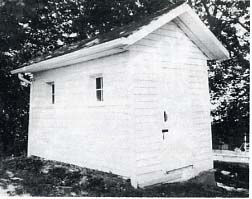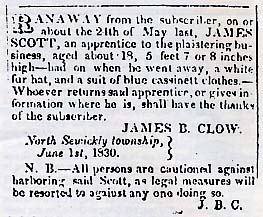
Click Here to Return to Milestones

The James Beach Clow Farmhouse was placed on the National Register of Historic Places by the U.S. Dept. of Interior on May 17, 1989 - Joining four other historic registered houses in Beaver County, including the Vicary House in Freedom, Pa. The National Register of Historic Places is the official list of the Nation's cultural resources worthy of preservation. It is administered by the National Park Service under the Secretary of the Interior. Properties listed in the National Register include district sites, building, structures and objects that are significant in American history, architecture, archeology, engineering and culture. The Clow home obtained listing on the National Register because of its significance as a well-preserved example of Greek Revival domestic architecture. Outside the large towns, in the rural areas, the Greek Revival style was generally expressed in more simple and tentative ways. Architecturally the Clow House is a rare survivor of a Greek Revival frame farmhouse fairly common to the area in the 1825-1860 period. The 1830 house owned by Frederick and Donna Schry, is located in North Sewickley Township at the corner of Chapel Drive and Ann Street. Set back 250 feet off Chapel Drive, on the crest of a hill, the house commands a 180 degree panoramic view of a rural/sylvan setting several miles to the east and south- The house consists of a front 2112 story rectangular front section and a 11/2 story rear ell section. The plan of the front section has a center hall with staircase flanked by one room, of equal size, on both first and second floor. The rear ell section contains two rooms on the first floor, family room and kitchen, with two attic bedrooms above. The shed section includes a recessed porch (now enclosed) and two small rooms, bathroom and laundry, behind the porch. The braced framework is covered with weatherboards of eastern white pine applied directly over the studs. The roof is covered with slate with built-in gutters. The pine, six over six double hung windows and louvered exterior shutters are original to the house. The kitchen, located at the rear of the ell section, has an enclosed staircase with "pie" steps leading to the two attic bedrooms. The basement has a cement floor and is fully excavated. The foundation is constructed of sandstone quarried 500 feet from the house. The large stones, include several up to ten feet in length, allow for an extraordinary foundation, and show no signs of settling or deterioration over the years. All four rooms in the front section have fireplace surrounds and one fireplace opening remains in the front room of the rear ell section. The kitchen and attic fireplaces of the rear ell have been closed. The original privy, located fifty feet north of the house, is rectangular, twelve by seven feet and is covered with the original weatherboard. The privy, once divided into two sections with a door on each end, has two original windows on the southeast side only. The interior walls were originally plastered and the interior partition has been removed and the floor cemented over. One door still retains its original Norfolk latch.
As a document of social and economic history, the 159 year old farmhouse related to the rural way of life in northern Beaver County from the early nineteenth to the mid-twentieth century. James B. Clow's father, James F. Clow, came from Scotland to Philadelphia in 1750. He served in the Revolutionary War as commander of Clow's Dragoons. He then moved to Pittsburgh and was one of the original signers of its charter when Pittsburgh was incorporated as a borough on September 9, 1792.1 He was nominated as Pittsburgh's first town clerk on May 19,1793. James Beach Clow (1771-1854) builder and owner of the farmhouse, was from Pitt Township, Allegheny County, Pa., following service in the War of 1812, purchased 550 acres of land in North Sewickley Township for $7,600.00 from Charles Von Bonhorst of Allegheny, Pa. on May 6, 1821. This land was originally part of Daniel Leet's District of Depreciation Lands. All of the lumber for the house was cut on a water powered reciprocating sawmill located on Brush Creek adjacent to the property. The mill was one-third owned by James B. Clow. The tax records list him as taxed for a trade in 1829. On June 11, 1830, he placed an ad in the Beaver County Argus newspaper requesting return of a "runaway apprentice to the plastering business" named James SCott. I have concluded he was a house plasterer at this period of time.
On July 10, 1830 he was commissioned Justice-ofthe-Peace by Governor George Wolf for the townships of North Sewickley, New Sewickley and Economy. He sold the house and farm, consisting of 100 acres, to his son, Samuel C. Clow, on February 18, 1844, for $3,000.00. James B. Clow lived in the house with his son Samuel till his death in 1844. He is buried in the Clow family plot with his wife in the North Sewickley Cemetery across from the Clow house. His gravestone is still visible. Samuel C. Clow (1803-1893), second owner, was listed as a farmer in the 1850 U.S. Census. He was active in the Abolition Movement in the period to the Civil War. The farm served as an Underground Railway Station during this period Samuel C. Clow's brother-in-law was John Brown, the radical abolitionist known for his raid on the U.S. Arsenal at Harper's Ferry, Virginia in 1859. John Brown's first wife, Diane Lusk Brown and Samuel Clow's first wife, Sophia Lusk were sisters from Hudson Township, Summit County, Ohio. In 1863, 700 houses were inspected for the Union Army on the farm. During the years of 1870-1878, the house served as a boarding home for boys and girls attending the North Sewickley Academy located across from the Clow House on Chapel Drive. Most of the students came from New Brighton. Samuel C. Clow lived in the house up to the time of his death in 1893. Following the death of his second wife, Mary, the farm was sold to James Jackson, Jr. in 1897. After James Jackson's death the property was inherited by his son R. Sharp Jackson in 1917 who operated the farm as a dairy. The milk was shipped in five gallon cans via the Pittsburgh, Harmony, Butler, and the New Castle Railway which passed near the farm. When the railway closed in 1937, the milk was delivered in bottles to homes in the Ellwood City and surrounding area. The basement of the Clow House, during this period, served as a wash and bottling area. The dairy operation closed in 1941. Following the death of R. Sharp Jackson in 1948, the farm passed to his widow, Anna Blance Jackson, who ceased all farming in 1950.111 The name Clow is not known in the area - even though James B. had eleven children and Samuel C. Clow had fourteen children - seven to his first wife and seven to his second wife.


1. Wilson, Erasmas. Standard History of
Pittsburgh, Pennsylvania.
Chicago, H.R. Cornell & Co., 1898. Page 72.
2. Deed, Charles Von Bonhorst to James B. Clow, date of record: July 25, 1821, Beaver County Court House, Beaver, Pa. Vol F, Page 230, 231.
3. North Sewickley Township Property Tax Records (reproduced) years 1822-1838. Held by Beaver County Resource & Research Center, Carnegie Free Library, Beaver Falls, Pa.
4. The Western Argus and Farmers Mechanics Register (Beaver, Pa.), June 11, 1830 (Held by Resource & Research Center for Beaver Co. & Local History)
5. Commission, Commonwealth of Pennsylvania to James Beach Clow, Date of Record: June 1830, Beaver County Court House, Beaver, Pa. Vol. 1, Page 510.
6. Deed, James Beach Clow to Samuel C. Clow, Date of Record: April 25, 1844. Beaver County Court House, Beaver, Pa. Volume W, Page 161.
7. Bausman, J.H. History of Beaver County
Pennsylvania, Volume 11.
The Knickerbacher Press, 1904, Page 22.
8. Warren, R.P. John Brown, the Making of
a Martyr New York:
Rayson & Clark, 1929, Page 22.
9. Account Book, Samuel C. Clow, 1863-1878
(Held by Frederick L.
Schry)
10. Interviews with Robert Sheehan, former
owner of the Clow
House (1960-1984) December 1, 7,10,1987.